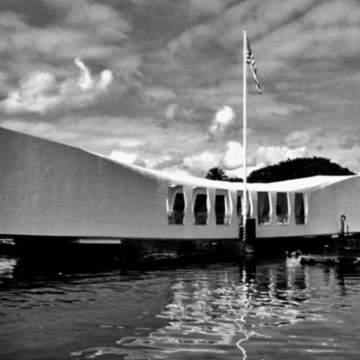Eloquently communicating its solemn message, this gleaming white, reinforced-concrete memorial straddles the sunken hull of the USS Arizona. Resting on 150-foot-deep concrete piles, the 21-foot-high memorial seems to be suspended on Pearl Harbor's rippling waters without visible means of support. A seemingly straightforward, gracefully simple design, it successfully addresses and augments the emotions elicited by the physical presence of that “day that will live in infamy.”
Visitors enter a narrow, darkened foyer and emerge onto a sunlit deck. Its open framework allows the beauty of the day and life to flow freely through, while at the same time offers bow-to-stern views of the battleship. A large opening in the center of the memorial's floor provides a direct glimpse down at the rusting hulk, a mere eight feet below, sitting in its watery grave and still leaking oil. Finally, visitors approach the far end of the memorial, where a white marble wall stands with the names of the 1,177 individuals who perished at this place. By this juncture, the architecture has receded and the impact of December 7, 1941, on the lives of these individuals, the nation, and the world are dramatically evoked.
Beyond the direct confrontation with history that it provides, the architecture of the memorial also operates at a symbolic level. The catenary curve of the roof, with its low point over the sunken ship, invokes the initial defeat followed by a triumphant rise, and the fragmented, jagged apertures illuminating the memorial wall express the violent destruction of the battle.
Alfred E. Preis (1911–1993) came to Hawaii in 1939 from Vienna, fleeing Hitler's Europe. Upon arrival he was employed by Dahl and Conrad. With the entry of the United States into World War II in 1941, Preis was interned for four months as a foreign national from a hostile country. Following his release, he worked for the Territorial Department of Public Works and then opened his own office. He later became the first executive director for the State Foundation on Culture and the Arts, and was responsible for conceiving the highly successful “Artist in the Schools” program.
The existence of the memorial owes something to Elvis Presley. Following the conclusion of World War II, the USS Arizona remained undecorated until 1950, when commander-in-chief in the Pacific Admiral Radford ordered a flag platform erected over the sunken hull. Six years later the platform was declared unsafe and removed. In response, the U.S. Congress authorized the building of an Arizona memorial and established a commission to raise private funds for its construction. A national campaign commenced on December 7, 1957, but after three years, was still far from its goal. On March 26, 1961, Elvis did a benefit performance at Pearl Harbor's Bloch Arena, raising over $64,000 for the memorial. More important, the concert sufficiently increased public awareness to raise the necessary construction funds from the private sector, Congress, and the Hawaii state legislature.





















